| FAQ |
| Members List |
| Social Groups |
| Calendar |
| Search |
| Today's Posts |
|
#1
|
||||
|
||||
|
I've been messing around with a set of 1964 GTO 9770716 cylinder heads lately and thought I'd post some pics and info to help illustrate some of the basic differences between the '64 and earlier heads in comparison to the '65 and later heads. Most of us are aware that 1965 was the year that the intake manifold bolt pattern was revised for the final time on Pontiac V8s, all of the currently available new aftermarket intakes will only fit the '65 and later heads.
A 1964 9770716 389 head is pictured at the top, a 1970 #13 400 head below. It's easy to see the difference between early 'L' shaped water ports and the round water ports on the late head as well as the different end bolt hole locations. The round center exhaust crossover port was last used on the 1964 heads.  The 1964 12-bolt intake covers the entire intake surface of the head in order to seal up the rear water port that isn't used. The '65 and later intakes use only 10 bolts and don't cover the entire length of the intake side of the head. These later heads use a freeze plug in the rear port on the driver's side head and a special 5/8" heater hose fitting that presses into the rear port on the passenger side head. The '64 intake in this instance uses a curved 5/8" hose fitting in the front water crossover to send water to the heater core and requires using a much longer 5/8" heater hose than the later heads. 1964 intake, showing the 'L' shaped water ports and full-length 12-bolt configuation along with the heater hose fitting in the water crossover. 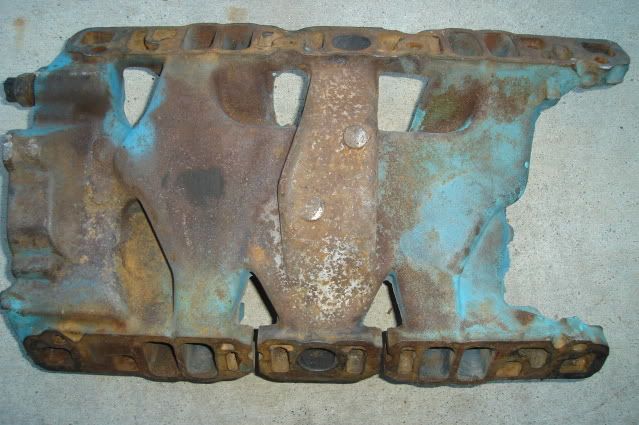  1966 intake, showing the round water ports and shorter 10-bolt configuration. 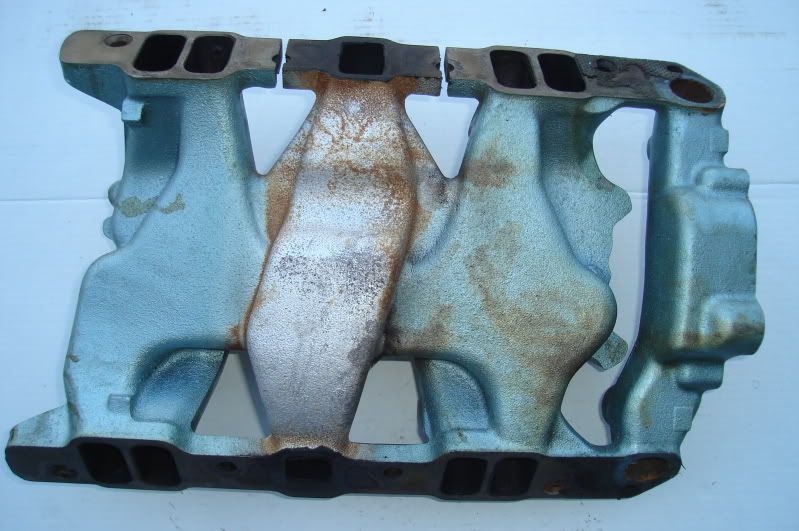 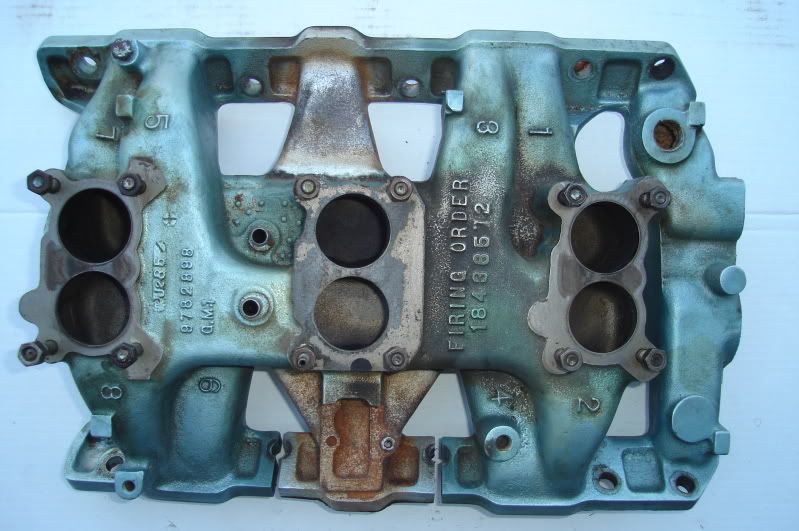 This pic should help to illustrate the water port mismatch when trying to run a '61 -'64 intake on '65 or later heads:  Taking a closer look you'll notice that the intake ports on the 1964 head are located a full .250" higher up in the head as compared to the 1970 head. Port entrance size is nearly identical between the two heads, 2.050" X 1.110" for 1964 and 2.070 X 1.100" in 1970. The '64 heads have a cleaner and more uniform rectangular shape in comparison to the '70 heads, a better (and slightly more expensive) casting technique perhaps? 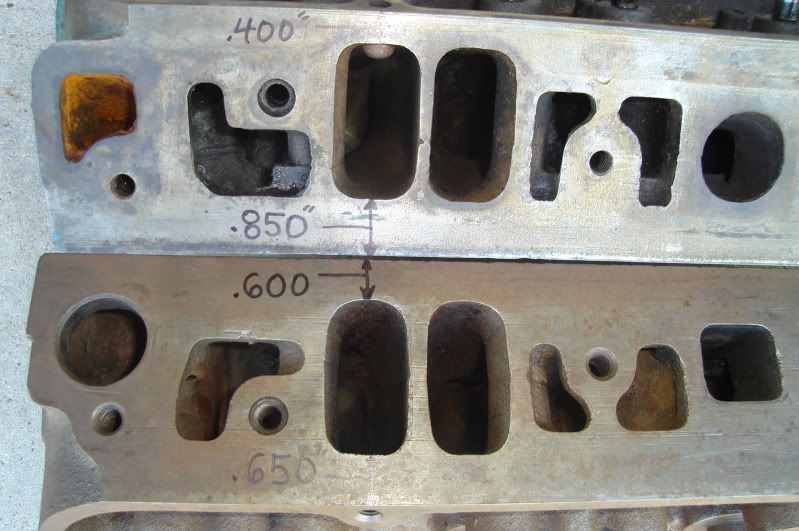 Some of you may have noticed this round casting protrusion in the roof of the two end intake ports on the '64 head, put there to seal off the bottom of the tapped holes for the valve cover bolts. Since the port entrances were dropped a full 1/4" on the '65 and later heads there's no need for it on the later design. Of interest on this note are the '73-'74 455 Super-Duty heads that have approximately 1/4" taller intake ports than standard heads, the valve cover bolt hole breaks into the roof of the intake port on these heads so it must be sealed up properly to prevent vacuum leaks. 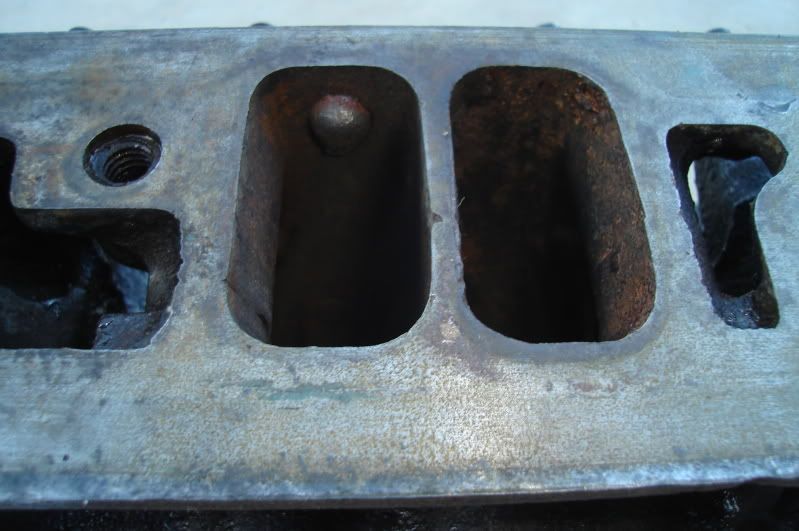 The picture below illustrates the visual difference between closed chamber heads (1964, top) and open chamber heads (1970, bottom). Not only are the chambers of different design, but the valve placement in relation to the center of the chamber is different and the valve angle in relation to the head deck is different as well between the early and late heads. The '64 9770716 GTO (and '63 -'64 421 HO) head has a 20 degree valve angle and uses 1.92"/1.66" valves, these were the big-valve Pontiac performance street heads of their time (standard 389/421 heads up through '64 all used 1.88"/1.60" valves). The early offset chamber placement doesn't allow the practical use of valves any larger than the 2.02"/1.76" valve sizes used in the race-oriented '62 -'63 421 Super-Duty heads. The 1970 #13 head uses the most current open chamber design that first appeared on the '67 #061 big Pontiac heads, it also has a 14 degree valve angle. 1967 was a transition year where both open and closed chamber heads were offered, as well as both 20 and 14 degree valve angle heads. The first 2.11"/1.77" big-valve street heads were offered in '67 as well, all were 14 degree valve angle. Low-performance standard heads used 1.92"/1.66" valve sizes. The valve location changed to the center of the chamber with the introduction of the 2.11"/1.77" valves and 14-degree valve angle heads, there was now more room for bigger valve sizes with the centered placement of the valves and chamber. 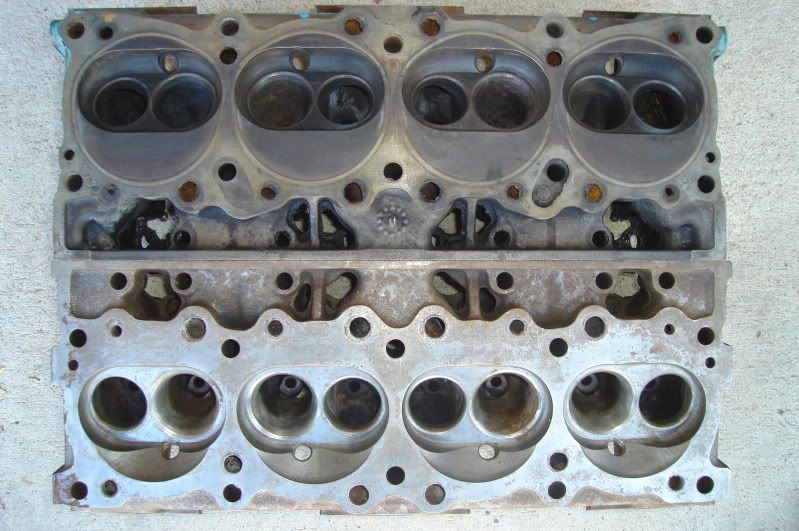 Not a lot of difference on the exhaust side of the head at least on the outside, the D-port configuration of the ports is very much the same on both early and late heads. The later heads do have additional accessory mounting bosses cast in to mount the A/C compressor, the '67 and earlier heads use an A/C bracket that is held down by two special longer outside end head bolts. 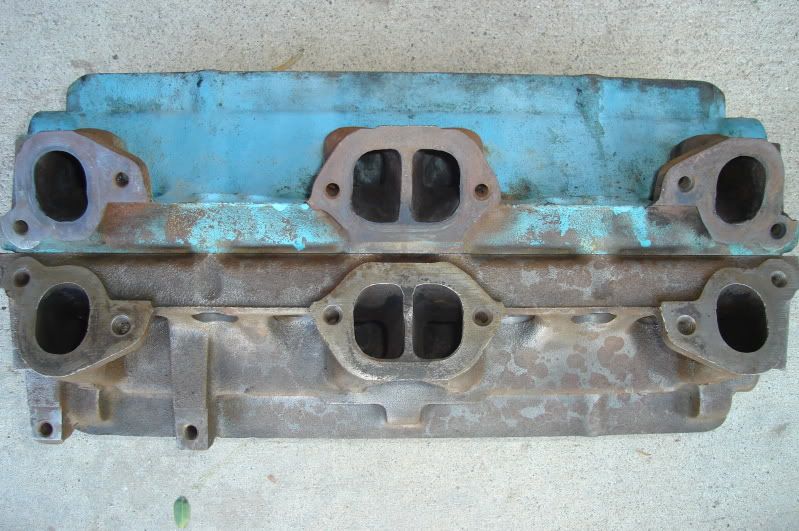 Under the valve cover there are quite a few differences between the early and late heads. The '64 head uses pressed-in rocker studs and has no sheetmetal pushrod guideplates as the pushods are guided by machined slots in the head casting, every GTO head up through '66 was made this way. The #13 1970 head happens to be a 4-barrel performance head for that model year so it has screw-in rocker studs and guideplates (not shown here). Low-performance heads made after 1966 had guideplates but still had pressed-in studs, by 1974 all Pontiac heads used screw-in studs and guideplates. Of interest are separate rocker stud bosses and the raised center 3 headbolt bosses under the valve cover on the '64 head. The valve spring installed height was 1.53" on the 1964 heads, in 1965 it was changed to 1.586" for the standard non-Ram Air heads. 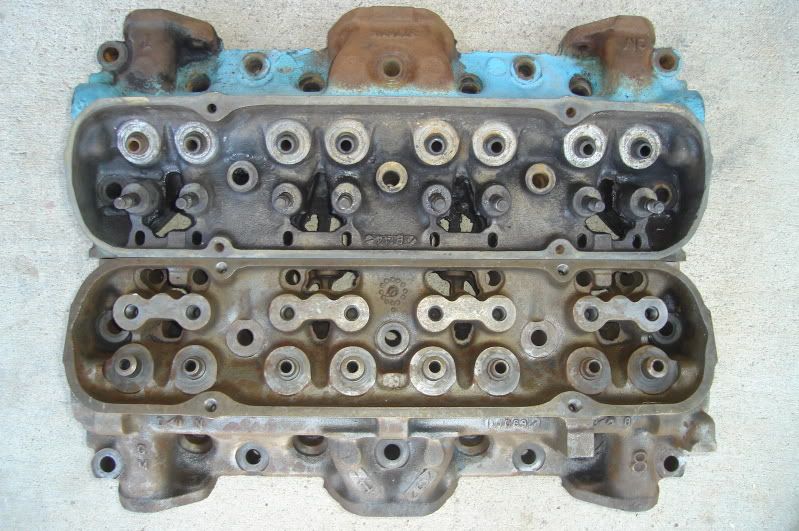 No differences of any real significance on the ends of the heads. 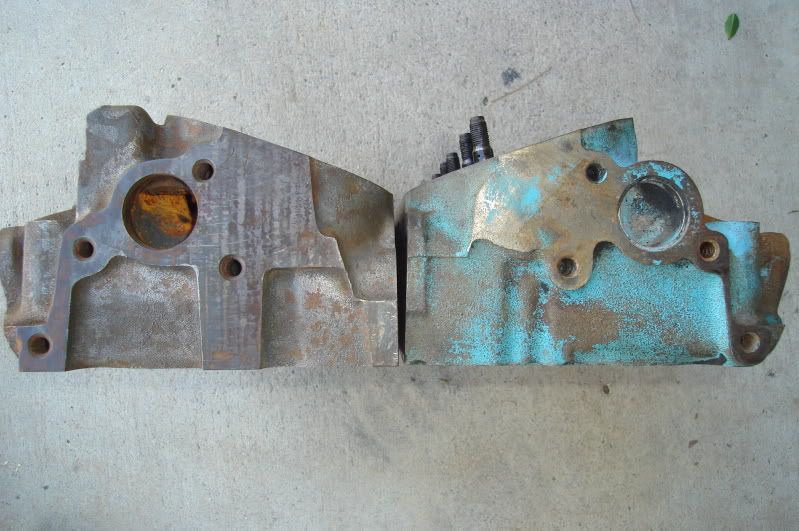 One thing I did notice was the 3-bolt pattern surrounding the freeze plug was slightly different when I went to bolt the early 9770716 head to my home-built head stand. One of the bolt holes didn't line up since I had built the two pivoting end plates of the stand using a later head as a pattern. 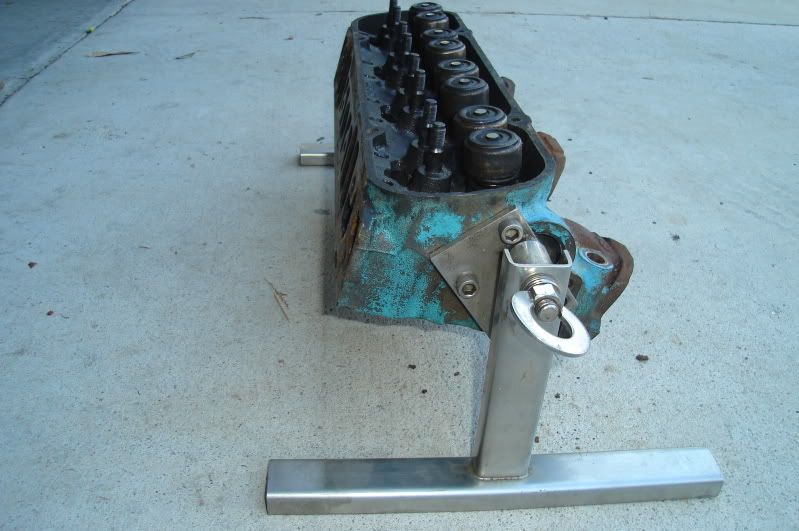 Hopefully this information (that I hope is fairly accurate) and series of pictures will help some of the Pontiac faithful here on PY to understand some of the differences between the early and late heads.   
|
| The Following 3 Users Say Thank You to b-man For This Useful Post: | ||
|
#2
|
|||
|
|||
|
Thank you b-man for your time to post this information as I'm sure it will come in handay for some of the people who work on pontiac engines and will take away a lot of the guess work-----BOB
|
|
#3
|
||||
|
||||
|
If I ever do a Boosted 64 type head I will have to remember to make sure that the bracket has the "64" style Bolt pattern on the mounting bracket.
Thanks for the Info. Tom Vaught
__________________
"Engineers do stuff for reasons" Tom Vaught Despite small distractions, there are those who will go Forward, Learning, Sharing Knowledge, Doing what they can to help others move forward. |
|
#4
|
||||
|
||||
|
Good pictures of the comparisons.
__________________
Skip Fix 1978 Trans Am original owner 10.99 @ 124 pump gas 455 E heads, NO Bird ever! 1981 Black SE Trans Am stockish 6X 400ci, turbo 301 on a stand 1965 GTO 4 barrel 3 speed project 2004 GTO Pulse Red stock motor computer tune 13.43@103.4 1964 Impala SS 409/470ci 600 HP stroker project 1979 Camaro IAII Edelbrock head 500" 695 HP 10.33@132 3595lbs |
|
#5
|
||||
|
||||
|
Thanks for posting this b-man. It answered some questions that I had. Your posts always inform and are easy to understand
|
|
#6
|
||||
|
||||
|
Pontiac added another bolt hole, near the intake side, on the end of the cylinder head. When they changed to the 11 bolt water pump. This hole is the pivot bolt hole for the alternator.
Photo #1 is a # 62 head, with 4 bolt holes. Photo #2 is a 7K3 head, with 5 bolt holes
__________________
Its ok to giggle and snicker, Dont laugh and point Last edited by Ollie; 06-13-2010 at 09:35 PM. |
|
#7
|
||||
|
||||
|
Quote:
|
|
#8
|
|||
|
|||
|
Excellent post. Thanks again, B-man
|
|
#9
|
||||
|
||||
|
Seems the raised ports on the earlier heads would have been a great feature to have kept around. I also wonder why the performance 1967 #670 heads stuck with the closed chamber 20° design? I haven't heard anything that good about the #061 heads, so I guess Pontiac must have changed many things on the 1968 open chamber heads?
Very cool to see all the side-by-side pics.
__________________
Mick Batson 1967 original owner Tyro Blue/black top 4-speed HO GTO with all the original parts stored safely away -- 1965 2+2 survivor AC auto -- 1965 Catalina Safari Wagon in progress. |
|
#10
|
||||
|
||||
|
Excellent reference post!
a minor clarification: quote Not a lot of difference on the exhaust side of the head at least on the outside, the D-port configuration of the ports is very much the same on both early and late heads. The later heads do have additional accessory mounting bosses cast in to mount the A/C compressor, the '67 and earlier heads use an A/C bracket that is held down by two special longer outside end head bolts. I dont know about A body or F body but B body cars in 1968 and 1969 had the AC comp on the head studs via a cast iron pivot cradle. Cradle had enough room for a spark plug socket to pass under (via right front wheelwell) At least to the extent of my personal ownership of GPs with 428/46 heads and a 428/16 heads |
|
#11
|
|||
|
|||
|
So if a fella wanted to use late style heads on a much older car with the reverse cooling, the would be out of luck, it would not bolt up. ?
|
| The Following User Says Thank You to Donovan For This Useful Post: | ||
|
#12
|
||||
|
||||
|
Didn't some of the early engines oil through the rocker studs?
__________________
I could explain all this to the girl at the parts store, but she'd probably call the asylum. White '67 LeMans 407/TH350/Ford 3.89... RIP Red '67 LeMans. 407/TH400/Ford 3.25 |
|
#13
|
|||
|
|||
|
Stuff like this is wonderful
I swear we should have a tech section somewhere just a lot of threads like this that are well detailed with pictures, so people can sort through stuff on their own It'd eliminate dozens of weekly questions
__________________
Clay Marsh 1967 GTO convertible Twin Turbo 5spd project  http://forums.performanceyears.com/f...d.php?t=618281 http://www.youtube.com/watch?v=eJ9KworCMRE |
|
#14
|
||||
|
||||
|
Quote:
The 670 heads were closed-chamber heads but they do have the 14-degree valve angle, otherwise the 2.11"/1.77" valves wouldn't fit. A very unique cylinder head that I think marked a new beginning of Pontiac V8 horsepower potential. Quote:
The later heads will bolt onto the early block no problem, the head bolt pattern is the same from '55 -'81. You'll need to use a later intake manifold that mates up with the heads, later valve covers as well as longer hollow pushrods and rocker arms that match the later heads. You may have mod the front of the later intake so it doesn't interfere with the early front timing cover, at the very least you'll need to plug the thermostat bypass hole in the front of the later intake. You will also need a later valley pan to be compatible with the later intake, the earlier valley pans are wider due to the higher port placement on the early heads. I found out about the wider early valley pans when I tried to use a '64 valley pan under a '66 Tri-Power intake with '71 #66 455 heads. I ended up trimming about 1/8" off each side of the '64 pan to make it work. Later on I noticed that '65 -'67 valley pans have 4 shallow notches cut to clear the intake runners. Up through the 1964 model year nearly all Pontiac V8s had the rocker arms oiled through the rocker studs rather than through the hollow pushrods. The stud-oiled rocker arms didn't have the oil spurt hole in the pushrod cup. The early '60 -'63 389 & 421 Super-Duty heads were pushrod oiled as well as the '63 -'64 9770716 389 & 421 heads. The 9770716 head is unique because it was the first non-SD head to be pushrod oiled. For quite a few years after 1964 the pressed-in rocker studs still had the oiling passages drilled in them for stud oiling. They must have had a ton of them left over and just kept on using up the older stock of drilled studs. Here is a picture of the rocker stud oiling passage in an early block that feeds oil to the hollow rocker studs on most of the '64 and earlier engines, taking oil from the camshaft bearing oil gallery. The '64 GTO 389 block pictured below doesn't actually use this passage since the rockers are oiled through the pushrods, the head gasket and the head itself serve to block it off to prevent any oil pressure loss. This oiling passage in the block was eliminated in 1965 since all Pontiac V8 rocker arms were oiled through the pushrods after 1964. 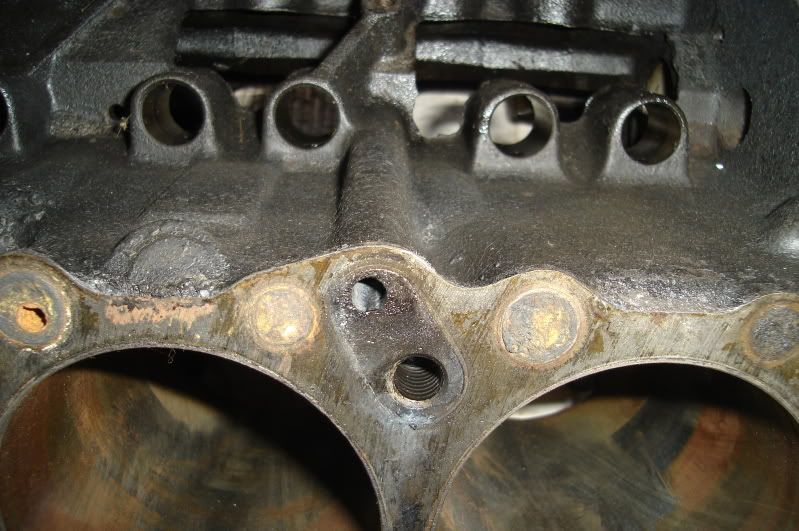 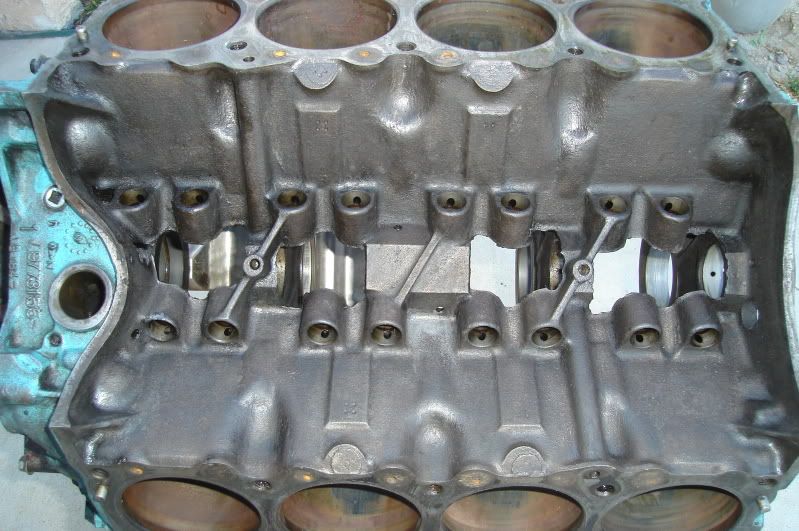
|
|
#15
|
||||
|
||||
|
Here's a look at one of the very early Pontiac V8 heads. 1959 was the 5th year of production for the Pontiac Strato-Streak V8 and the very first year of the now famous 389, they were all equipped with casting # 531395 heads.
Valve sizes are 1.88" intake and 1.60" exhaust. 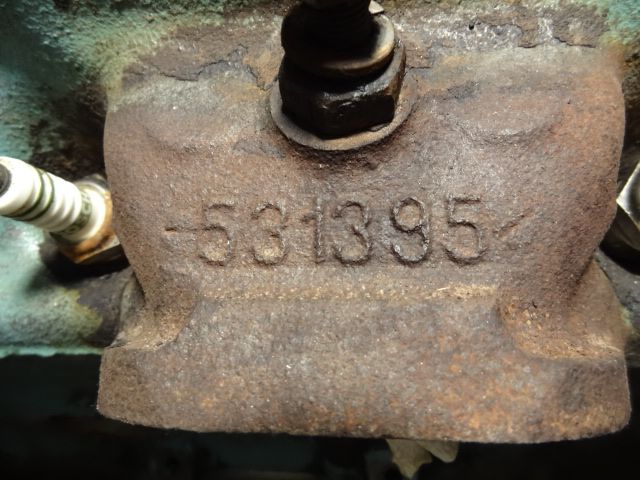 The intake and exhaust crossover port placement is exactly the same as the 1961 - 1964 heads. The bolt pattern is identical as well. 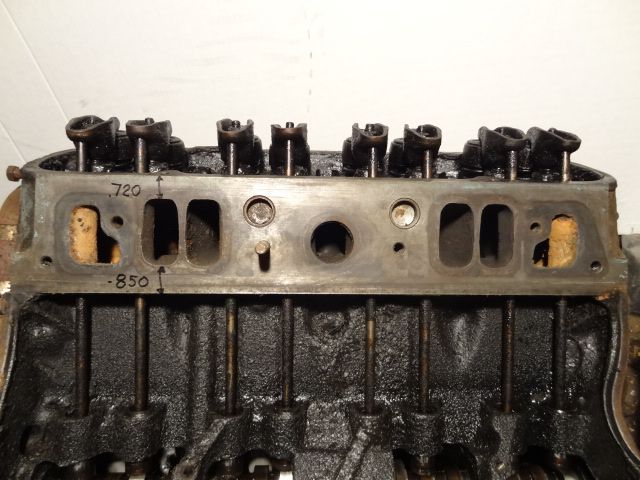 Here is a 1964 intake gasket laid over the 1959 head. As you can see the water ports are in a completely different location.  Here's the 1959 intake manifold. 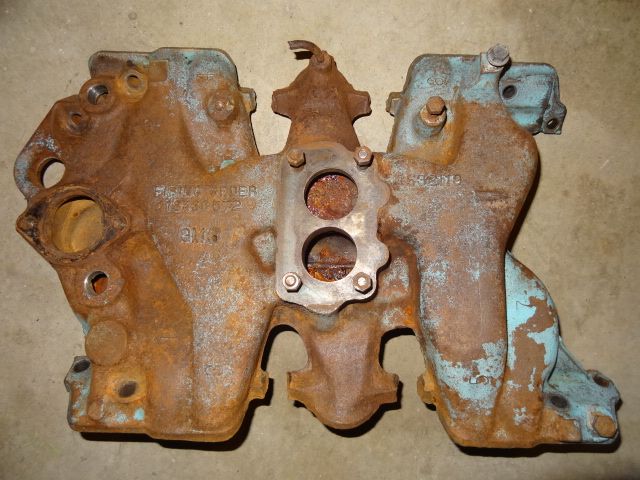 There isn't much material cast into it in the exhaust crossover region, it uses studs, castle nuts and large thick flat washers to clamp down on and seal the ports in this area. It doesn't use a thermostat bypass port to the timing cover. 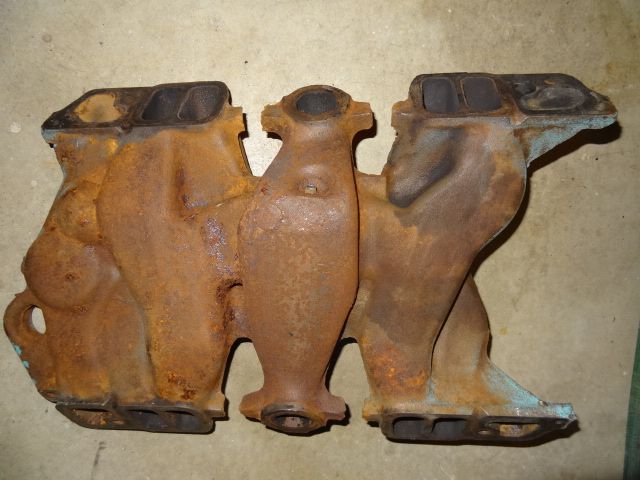 Here is where we will see one huge difference between the 1959 (1955 - 1960) and the '61 - '64 heads. The intake ports are almost the same exact size as the '64 head at 2.050" X 1.100", but the cylinder head itself is .320" taller than the later heads. The valve cover rail is higher, both cylinder heads have the same .850" measurement from the cylinder head deck to the bottom of the port. However the '59 head measures .720" above the port compared to only .400" for the '64 head. 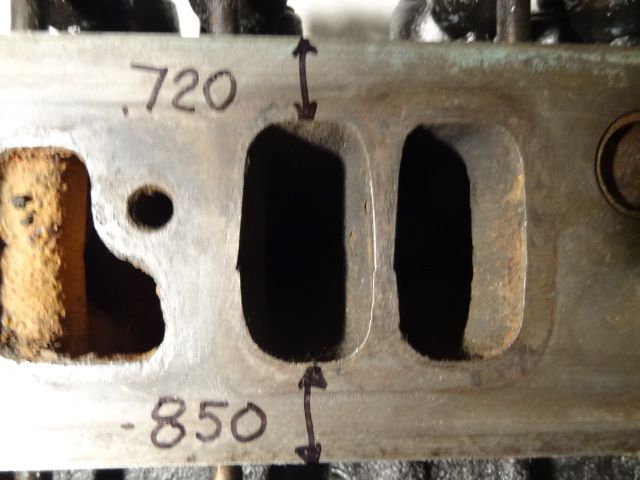 Note that since the valve cover rail is so much higher on the '59 head it doesn't have the small bump cast into the roof of 2 of the ports to keep the valve cover bolt hole from breaking into the port roof like on the '64 head. Also take note that there are no openings on the intake side of the head that lead to the crankcase like on the later heads. 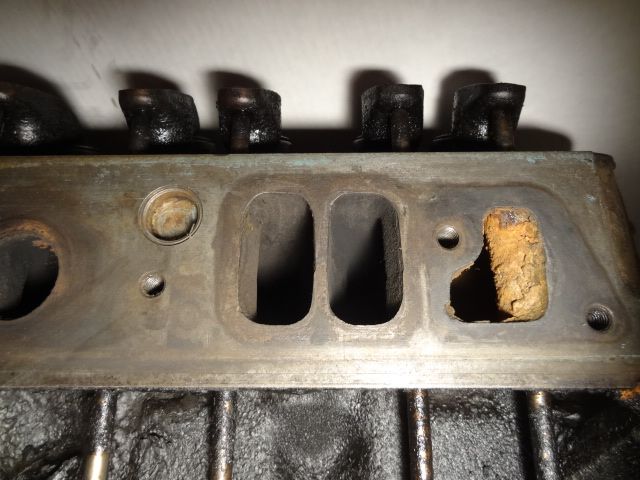 Another unusual feature that likely was the main reason the heads were so much taller, are the 4 intake valve guide vent holes in the side of the head just below the valve cover rail. These were put there to provide a vacuum break for the valve guides, to prevent them from sucking oil down into the combustion chambers. These tall heads must have made these early engines look just a little bigger and wider than their later cousins. 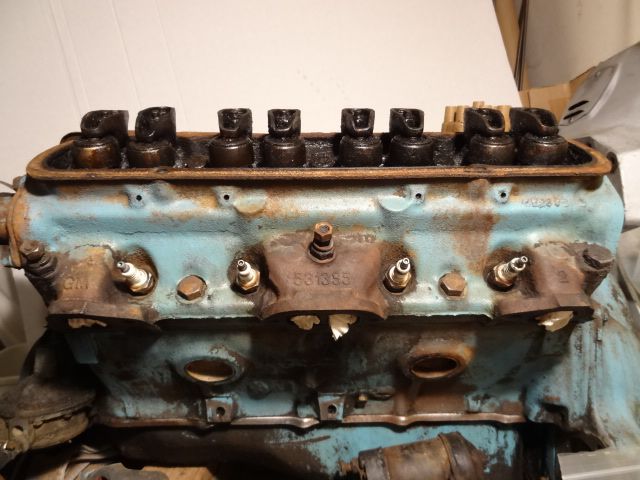 Vent hole diagram from the factory manual. 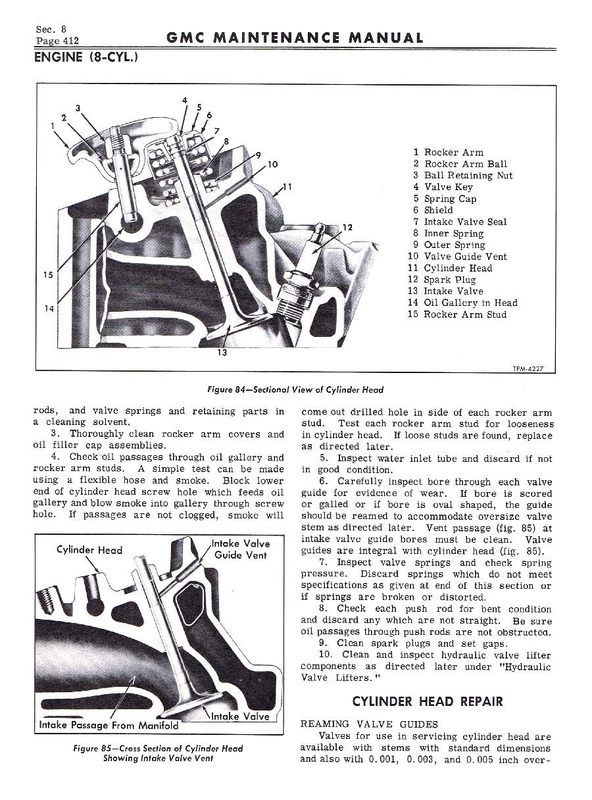 A closer look at the vent holes. 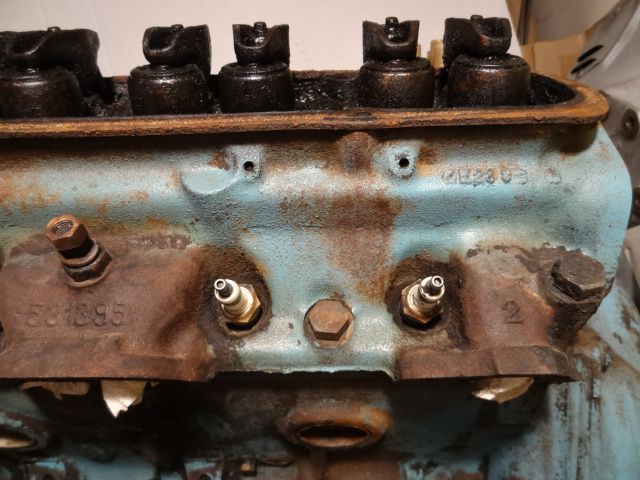 1959 was the last year that Pontiac used reverse cooling, pumping water first through the front of the cylinder heads and then down through the block. Here is one of the water fittings on the front of the head. 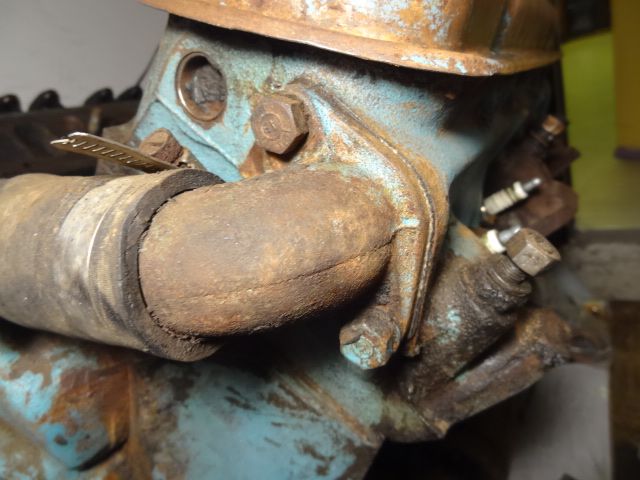 A view of the rear of the head, better showing the placement of the water channel. The small soft plug above the water channel blocks off the ends of the oil passage cast into the head that feeds oil to the rocker studs. All Pontiac heads oiled the rockers through the rocker studs until the introduction of the '63 -'64 9770716 heads, the only exception being the early Super Duty heads. 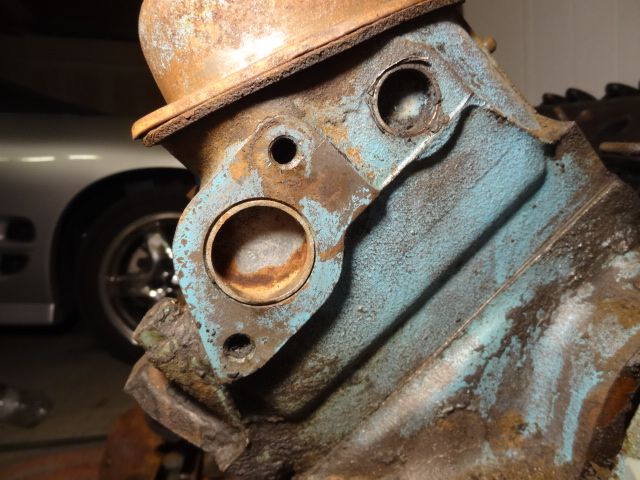
__________________
1964 Tempest Coupe LS3/4L70E/3.42 1964 Le Mans Convertible 421 HO/TH350/2.56 2002 WS6 Convertible LS1/4L60E/3.23 |
|
#16
|
|||
|
|||
|
I know this is a very old but very interesting thread. I have some 9770716 heads and also some #48 heads that I am working on. I was curious to look into more details about the valve placement on the early vs. late heads. As b-man mentioned above, the “valve placement in relation to the center of the chamber is different and the valve angle in relation to the head deck is different as well between the early and late heads” and the valve angle changed from 20 to 14 degrees. He also said “the valve location changed to the center of the chamber with the introduction of the 2.11"/1.77" valves and 14-degree valve angle heads”
But just where are the valves? Here is what I did. I mocked up one bank of a block with 4 pistons at TDC and zero decked. I blued up the tops of the pistons and marked center lines on them. Then I put each head on the block with no valves and no gasket. I dropped an 11/32 drill down each valve guide and spun it by hand a little to mark the piston tops. I then measured with a dial caliper as best I could where the valve guide centerlines intersected the pistons. I averaged the results from the 4 pistons With the 9770716 heads the valve centers intersect the pistons just over a half inch below the horizontal centerline. The exhaust valve center is about .94” from the transverse centerline and the intake is about .88” from the transverse centerline. See the first photo. With the #48 heads, the valve centers intersect the pistons seeming exactly on the horizontal centerline. I guess that is what b-man meant when he said the valve location changed to the center of the chamber. I measured the exhaust valves to be 1.095” from the transverse centerline and the intakes to be .882” from the transverse centerline. See the second picture. This is all important if one wants to put the valve reliefs in the right place on the piston tops. The rest of the valve train geometry is also interesting. It looks like on the early heads, each valve train is coplanar and parallel to each other. It looks like the everything is 1.818 to 1.820 apart. Lifters, pushrods, rocker studs, rockers and valves are all at the same spacing. With the later heads, of course the lifters are still the same, but the valves are about .160 further apart. I will measure it in more detail later, but it looks like each component in the chain gets a little further apart. |
|
#17
|
||||
|
||||
|
I beg to differ with post 10s statement in this string that there is not much of a difference in the pre and post 67 exh ports.
The reduction in the valve inclination angle added to the exh flow capacity of the new designed heads a great deal even though to a quick look over by a uninformed eye they seem very much the same, and yes this change did not do hardly any good for intake flow numbers , but thru the usage of a now 10% bigger intake valve it afforded it had huge benefits in allowing the motor to make better power with the air and fuel amounts it’s already consuming. The continued use a 30 degree seat combined with the new 2.11” valve size and the D ports heads small 1.60” intake bowl throat size forces the high velocity air and fuel mixture to slow down above the back of the valve,turn and exit around the 360 degree perimeter of the valve and fill up the chamber FIRST as opposed to the earlier valve inclination angle that by .300” lift forces the air and fuel mixture to just wash its way down the cylinder bore, all of which causes more ware and crappy emissions numbers!
__________________
Wernher Von Braun warned before his retirement from NASA back in 1972, that the next world war would be against the ETs! And he was not talking about 1/8 or 1/4 mile ETs! 1) 1940s 100% silver 4 cup tea server set. Two dry rotted 14 x 10 Micky Thompson slicks. 1) un-mailed in gift coupon from a 1972 box of corn flakes. Two pairs of brown leather flip flops, never seen more then 2 mph. Education is what your left with once you forget things! |
|
#18
|
|||
|
|||
|
Quote:
Here are a couple diagrams which illustrate the valve placement changes. |
|
#19
|
||||
|
||||
|
Good information is still good information even if it's dated a bit.
Pontiac also continued to use "low" lift cams with generous off seat timing and slow opening lift rates. With few exceptions that stayed with 30 degree intake seats which they felt were best with those camshafts. Anyhow, a few years back we were preparing a 455 for a 1981 Firebird to get it finished in time for the Pontiac race at Norwalk in August. The CNC ported KRE heads and custom roller cam were not going to make it in time so I grabbed up a set of 1969 #46 heads and very quickly got them ready. I ground the valves to the stock 45 degree angles and just touched the seats to clean them up and get a good seal. The only mods were adding screw in studs, better springs and the end bolt holes. They were NOT ported in any way, not even a port match to the intake gaskets and we used the stock small valves in them with 45 degree intake seats. I also grabbed up a used Crower cam from the back room from another project and finished off the 455 just in time for the Norwalk race. I was expecting maybe low to mid 12's out of the combo at best. Right off the trailer the car went high 11's and continued to run there all weekend in the heat of August. Pretty decent performance from a pretty "basic" combination topped off with small valve heads that typically get bypassed by folks looking for the big valve versions......FWIW........Cliff
__________________
If you can read this, thank a teacher. If you can read this in English, thank a Veteran! https://cliffshighperformance.com/ 73 Ventura, SOLD 455, 3740lbs, 11.30's at 120mph, 1977 Pontiac Q-jet, HO intake, HEI, 10" converter, 3.42 gears, DOT's, 7.20's at 96mph and still WAY under the roll bar rule. Best ET to date 7.18 at 97MPH (1/8th mile), |
|
#20
|
|||
|
|||
|
This thread is 11 years old now and still great information to bring back from time to time and review. B-man has posted a number of them with good side by side comparisons of various engine parts. I remember the one about different engine block castings over the years which had a number of details I had never seen or thought about much. This is a great way to help bring new people into the Strato Streak fold. Thanks B-man!!
|
| Reply |
| Thread Tools | |
| Display Modes | |
|
|